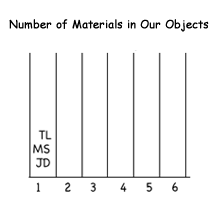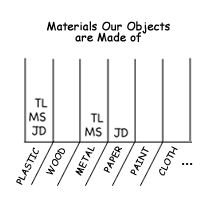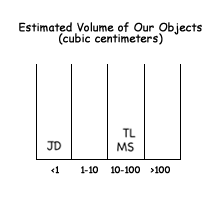How can we describe our personal objects?
2. Collect and record data about our objects
Students weigh, measure, estimate volumes, and consider the materials that make up their objects. The data log in their science notebooks will guide them through the task of data collection.
You can help by:
- Watching for logjams at the pan balance and volume stations
- Helping students identify materials that are unfamiliar to them
- Reminding students how to use the gram weights if they are having trouble
- Helping estimate volumes, using the three volume blocks for reference (note that students are asked only for the range into which their object falls: less than 1cc, 1–10 cc, 10–100 cc, more than 100 cc)
Crowd control: Having each person in a group start with a different measurement or observation will minimize the time students need to wait to use the pan balance or the volume blocks.
As students finish recording their data in their notebooks, ask them to share it with the class by
- entering the materials data and volume data in the class histograms
- putting their object in its proper place on the weight line.
You can help by demonstrating how to build the histograms, i.e., by entering students initials in the proper row or column, making sure the initials are written at about the same size, as shown in the examples.
Note: By comparing the heights of the columns of initials in Histograms 1 and 2, students can quickly see how their objects make use of different materials.

Histogram 1: Number of Materials in our Objects

Histogram 2: Materials Our Objects are Made of

Histogram 3: Estimated Volume of Our Objects
Once all the volume data has been added, students can see where there are clusters of data and get a general picture of how the volumes of the personal objects are distributed across the four categories.



